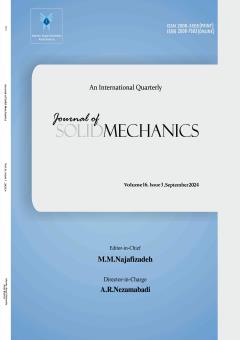Geomechanical Modeling for Determining Safe Mud Window and Evaluating Wellbore Wall Stability Using Numerical Simulation: A Case Study
Subject Areas : Mechanics of Solids
Mohammed Rasmi Raheem Alomairi
1
,
Mojtaba Rahimi
2
*
![]()
1 - Department of Petroleum Engineering, Science and Research Branch, Islamic Azad University, Tehran, Iran
2 - Department of Petroleum Engineering, Khomeinishahr Branch, Islamic Azad University, Khomeinishahr/Isfahan, Iran
Keywords: Wellbore stability, Azimuth, Mohr-Coulomb failure criterion, Mogi-Coulomb failure criterion, Safe mud window. ,
Abstract :
Mohr-Coulomb and Mogi-Coulomb failure criteria and caliper logs were utilized to determine the safe mud window. The results demonstrated that the formations located at the north wing of the studied oil field are more stable than the other zones. Among the investigated zones, Zone 5 is the most stable and Zone 6 is the least stable zone in terms of shear stability. Zones 1 and 2 in the south wing and Zones 3 and 4 in the middle wing of the oil field are also highly unstable. The Mohr-Coulomb failure criterion is more competent in predicting the stability of the wells compared to the Mogi-Coulomb failure criterion. The main reason for instability in the wells of this oil field is the selection of non-proper mud weight (usually far smaller than optimal mud weight) while drilling. The least mud window is in the middle zone in Well 3, and the safe mud window is about 15 Mpa in other parts of the field. In Zones 6 and 7 of the field, the safe mud window is 22.95 and 32.92 MPa, respectively. A 40-degree azimuth is the safe drilling route to decrease the instability of wells during drilling operations in this field.
[1] Hung Tran, N., Do, D. P., Ngoc Vu, M., Thu Nga Nguyen, T., Tho Pham, D., & Truong Trieu, H. (2022). Combined effect of anisotropy and uncertainty on the safe mud pressure window of horizontal wellbore drilled in anisotropic saturated rock. International Journal of Rock Mechanics and Mining Sciences, 152, 105061. https://doi.org/https://doi.org/10.1016/j.ijrmms.2022.105061
[2] Lyu, Z., Lei, Q., Yang, L., Heaney, C., Song, X., Salinas, P., Jackson, M., Li, G., & Pain, C. (2021). A novel approach to optimising well trajectory in heterogeneous reservoirs based on the fast-marching method. Journal of Natural Gas Science and Engineering, 88, 103853. ttps://doi.org/https://doi.org/10.1016/j.jngse.2021.103853
[3] Qiu, Y., Ma, T., Liu, J., Peng, N., & Ranjith, P. G. (2023). Poroelastic response of inclined wellbore geometry in anisotropic dual-medium/media. International Journal of Rock Mechanics and Mining Sciences, 170, 105560. https://doi.org/https://doi.org/10.1016/j.ijrmms.2023.105560
[4] Fan, X., Zhang, M., Zhang, Q., Zhao, P., Yao, B., & Lv, D. (2020). Wellbore stability and failure regions analysis of shale formation accounting for weak bedding planes in ordos basin. Journal of Natural Gas Science and Engineering, 77, 103258. https://doi.org/https://doi.org/10.1016/j.jngse.2020.103258
[5] Luo, A., Li, Y., Wu, L., Peng, Y., & Tang, W. (2021). Fractured horizontal well productivity model for shale gas considering stress sensitivity, hydraulic fracture azimuth, and interference between fractures. Natural Gas Industry B, 8(3), 278–286. https://doi.org/https://doi.org/10.1016/j.ngib.2021.04.008
[6] Yang, X., Shi, X., Meng, Y., & Xie, X. (2020). Wellbore stability analysis of layered shale based on the modified Mogi–Coulomb criterion. Petroleum, 6(3), 246–252. https://doi.org/https://doi.org/10.1016/j.petlm.2019.11.002
[7] Mondal, S., & Chatterjee, R. (2019). Quantitative risk assessment for Optimum Mud weight window design: A case study. Journal of Petroleum Science and Engineering, 176, 800–810. https://doi.org/https://doi.org/10.1016/j.petrol.2019.01.101
[8] Darvishpour, A., Cherachi Seifabad, M., Wood, D. A., & Ghorbani, H. (2019). Wellbore stability analysis to determine the safe mud weight window for sandstone layers. Petroleum Exploration and Development, 46(5), 1031–1038. https://doi.org/https://doi.org/10.1016/S1876-3804(19)60260-0
[9] Zhang, S., Wang, H., Qiu, Z., Cao, W., Huang, H., & Chen, Z. (2019). Calculation of safe drilling mud density window for shale formation by considering chemo-poro-mechanical coupling effect. Petroleum Exploration and Development, 46(6), 1271–1280. https://doi.org/https://doi.org/10.1016/S1876-3804(19)60280-6
[10] Kadkhodaie, A. (2021). The impact of geomechanical units (GMUs) classification on reducing the uncertainty of wellbore stability analysis and safe mud window design. Journal of Natural Gas Science and Engineering, 91, 103964. https://doi.org/https://doi.org/10.1016/j.jngse.2021.103964
[11] Beheshtian, S., Rajabi, M., Davoodi, S., Wood, D. A., Ghorbani, H., Mohamadian, N., Alvar, M. A., & Band, S. S. (2022). Robust computational approach to determine the safe mud weight window using well-log data from a large gas reservoir. Marine and Petroleum Geology, 142, 105772. https://doi.org/https://doi.org/10.1016/j.marpetgeo.2022.105772
[12] Qiu, Y., Ma, T., Peng, N., Liu, Y., Liu, J., & Ranjith, P. G. (2023). Wellbore stability analysis of inclined wells in transversely isotropic formations accounting for hydraulic-mechanical coupling. Geoenergy Science and Engineering, 224, 211615. https://doi.org/https://doi.org/10.1016/j.geoen.2023.211615

